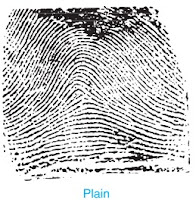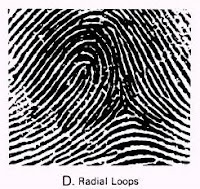Types of Fingerprint Patterns
What are Different Types of Fingerprint Patterns?
1. Arches
Arches are found in approx 5% of the recorded fingerprints. In an Arch pattern, ridges enter from one side travel to the other side, and lift slightly at the center of the pattern (like a wave) finally exiting from the opposite side.
Based on the nature of Arches they are further divided into two types i.e. Plain Arch and Tented Arch.
(a) Plain Arches
(b) Tented Arches
2. Loops
Around 60-65% of the recorded fingerprints are loop which makes it the most common fingerprint pattern in the population. A loop is formed when one or more ridges enter from a side (either left or right), continuing up to the center of the pattern, recurving around the core forming a loop, and then flowing back and terminating/exiting from the same side of the pattern.
A loop always has one delta and a core and at least one ridge passes freely between the delta and the core. Based on the direction of opening and closing the loops, they are further subdivided into two types:
(a) Radial Loops
(b) Ulnar Loop
3. Whorls
Whorl is found in the approx 30-35% of the recorded fingerprints of the population, making it the second most common fingerprint pattern after the loops. In a whorl, the ridge enters from a side making a complete spiral around the core of the fingerprint and terminate or tend to terminate at the core.
A whorl has 2 deltas and one core and the imaginary line drawn between two deltas must cross at least one recurving ridge to call the pattern a whorl. These types of whorls are known as plain whorls.
4. Composites
Composites are the 4th category of the fingerprint pattern. They are a mixture of Arches, loops, and Whorls. Around 1-2% of the population have these composites. Based on the nature of ridge movements, composites are classified into 4 types:
(a) Central Pocket Loops
(b) Double/ Twinned Loops
As the name suggests, a twinned loop contains a double-loop pattern. The two loops either overlap or surround each other and contain the point of the core exiting towards the different delta. The double loop pattern is sometimes referred to as the "Ying-Yang" symbol.










